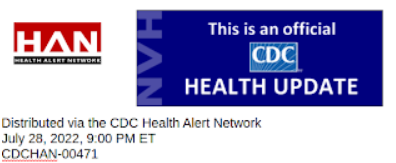
#16,908
Yesterday, the CDC reported over 4,900 confirmed Monkeypox cases in the United States, a number that - now with improved testing - continues to increase each week (see below). Globally, over 21,000 cases have been reported, although both numbers are believed to be badly under-counted.
The CDC also released a detailed technical report (below) on Monkeypox, along with an updated HAN Advisory with information for clinicians on treatment options, including the investigational antiviral Tecovirimat (also known as TPOXX or ST-246).
While these reports provide a lot of valuable information, they also point out gaps in our understanding of the Monkeypox threat, including (but not limited to):
Both reports are technical and quite lengthy, and are likely of greatest interest to clinicians and public health officials. I've only included some excerpts below, follow the links to read them in their entirety.
Executive Summary
Scientists at the U.S. Centers for Disease Control and Prevention (CDC), along with state and local public health partners, are tracking 3,487 cases of monkeypox in the United States as of July 25, 2022. CDC is also tracking multiple clusters of monkeypox that have been reported globally in 69 countries that do not normally report monkeypox.
CDC is urging healthcare providers in the United States to be on alert for patients who have rash illnesses consistent with monkeypox. Distinguishing features include papules, vesicles, pustules, or scabs that are deep-seated, firm or rubbery, and have well-defined round borders. The lesions can sometimes be umbilicated, i.e., have a dent in the middle of them. They may be painful, painless, or itchy. People with monkeypox may develop symptoms including fever, headache, muscle aches, exhaustion, or swollen lymph nodes.
Monkeypox can spread between people through close contact, skin-to-skin contact including sexual contact with a person with monkeypox, or contact with contaminated fomites (e.g., shared linens). While anyone can catch monkeypox if they have close contact with someone who has monkeypox, regardless of gender identity or sexual orientation, many of those affected in the current global outbreaks are gay, bisexual, or other men who have sex with men. Healthcare providers should be on alert for monkeypox regardless of a patient’s travel history, gender identity, or sexual orientation; reported contact with someone who has monkeypox or who has a rash suspicious for monkeypox may assist with clinician decision-making. Additional clinical guidance is available on the CDC website.
Table of Contents
The updated HAN (#471) was released by the CDC late yesterday evening.
Summary
As of July 28, 2022, the Centers for Disease Control and Prevention (CDC) and state and local public health partners are reporting 4,907 cases of monkeypox in the United States across 46 states, Washington, D.C., and Puerto Rico. CDC is also tracking multiple clusters of monkeypox that have been reported globally, including in 71 countries that normally do not report monkeypox.
This Health Alert Network (HAN) Health Update serves to alert clinicians on commercial testing capability, collecting clinical specimens for testing, and using TPOXX® (tecovirimat) for treating monkeypox.
Background
Since May 2022, CDC has been urging healthcare providers in the United States to be on alert for patients who have rash illnesses consistent with monkeypox. Distinguishing features of the rash include papules, vesicles, pustules, or scabs that are deep-seated, firm or rubbery, and have well-defined round borders. Vesicular or pustular stages of the lesions are often umbilicated (i.e., have a dent in the middle of them). They may be painful, painless, or itchy. People with monkeypox may develop symptoms including fever, headache, muscle aches, exhaustion or swollen lymph nodes during the prodromal period preceding the rash or with the rash.
Recommendations for Healthcare Providers on Diagnostic Testing
The public health response to monkeypox depends on timely and comprehensive laboratory testing and reporting of those results. Tests should be performed on persons for whom monkeypox is suspected based on clinical presentation and epidemiologic criteria. Positive diagnostic results from testing of skin lesion material for Orthopoxvirus or Monkeypox virus DNA in persons without epidemiologic criteria or known risk factors should be verified through repeat testing and/or confirmatory testing.
If there are no identified epidemiologic risk criteria for monkeypox infection, other possible causes of rash in adults should be considered, including secondary syphilis, herpes, and varicella zoster. In children without identified epidemiologic risk criteria for monkeypox, varicella zoster and molluscum contagiosum (MC) should be considered in the differential diagnosis. MC is an infection caused by a poxvirus (molluscum contagiosum virus) that is diagnosed more often in children than in adults. MC infection is usually a benign, mild skin disease characterized by lesions that may appear anywhere on the body. CDC’s FDA-cleared non-variola virus test used within the Laboratory Response Network laboratories and most commercial laboratories, does not cross-react with molluscum contagiosum virus. In children and adolescents, as in adults, other potential etiologies of illness should be tested for in parallel with or before Monkeypox virus testing, based on clinical presentation and epidemiologic criteria.


